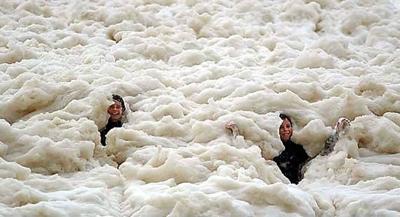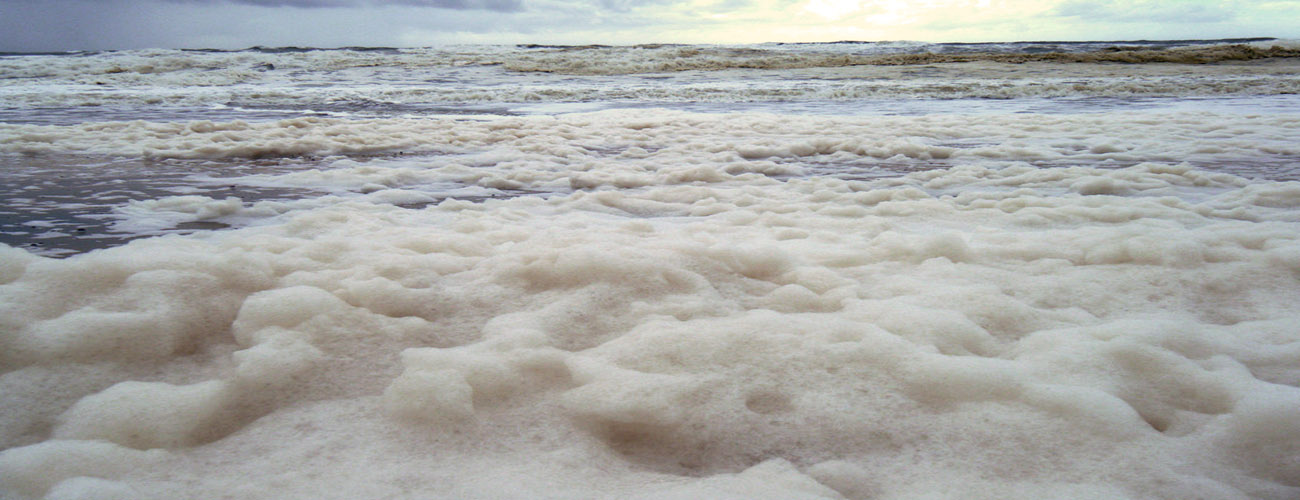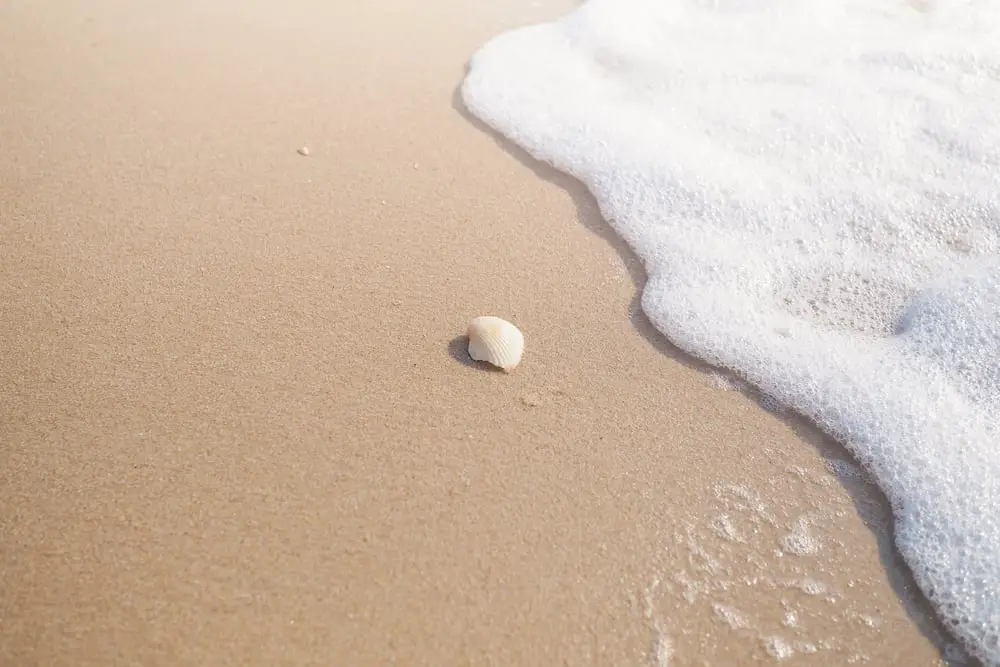Sea foam is a result of organic matter, such as algae, and dissolved organic compounds in seawater but is Sea Foam dangerous?
Sea foam is generally not dangerous. Because it forms from organic matter in seawater, those with compromised immune systems should avoid direct contact & report excessive foam, as it may indicate H2O quality issues of the surrounding sea and vital elements in determining whether it poses a risk.
In any amount, natural sea foam is usually harmless–but, as marine biologists in California discovered a few years ago–not always and we will take a look at this not-so-natural phenomenon.
Introduction:
Sea foam, a natural phenomenon occurring on coastal shores worldwide, often sparks curiosity and wonder among beachgoers. However, there is a common question lingering in the minds of many: Is sea foam dangerous?
While sea foam adds an aesthetic charm to the coastal landscape, concerns about its safety arise due to occasional reports of pollution and toxins found within it. Understanding the science behind sea foam formation and its potential risks is essential for ensuring ocean safety and enjoyment for all.
In this exploration, we delve into the composition of sea foam, the factors influencing its formation, and the implications for beachgoers and marine ecosystems alike. Through a balanced examination, we aim to shed light on the complexities of sea foam and provide insights into its safety for those who cherish coastal environments.
Is Sea Foam Dangerous
When we visit the shoreline, one of the most common sights alongside the rhythmic waves is ocean foam, often playfully chased by children and observed with wonder by beach-goers. But a question that frequently surfaces is, is sea foam dangerous?
The characteristics and safety of this frothy substance can be quite perplexing. Generally, sea foam is a natural occurrence, formed when the agitation of seawater, full of dissolved organic matter and proteins, creates bubbles that stick together. While often harmless, there are times when the foam is dangerous to sea animals and humans alike, due to its potential composition.
Ocean foam that’s tinged brown or reddish may indicate the presence of harmful algal blooms, which can contain toxins dangerous to both marine life and people. These harmful toxins, produced by certain species of algae, can be a threat to those who ingest or come into contact with the contaminated water.
With these outbreaks, foam dangerous to sea life is concerning, as it can lead to massive fish kills and poison other sea animals that come into contact with it. Additionally, the toxins can become airborne, posing risks to those breathing in the sea air near the ocean foam.
It’s essential to understand that not all foam is dangerous. Much of the time, beach foam is simply organic and completely harmless to humans and wildlife. For instance, the foam produced by the crushing of waves against the shore can be a regular and safe sight. However, the existence of foam dangerous to the ecosystem is a reminder of the delicate balance within our oceans.
Is Sea Foam Dangerous for Humans

While we can often enjoy the playful sight of sea foam dancing along the water’s edge, it’s always prudent to remain aware of the potential risks. In some cases, foam dangerous to beach-goers and sea animals alike can be an indication of a larger environmental issue. Therefore, it’s crucial to stay informed and exercise caution, especially during algal bloom events, to ensure that a day at the beach remains a healthy, enjoyable experience for everyone.
In general, sea foam is not considered harmful to humans. The organic matter present is natural and comes from marine sources. However, there are a few considerations to keep in mind:
Microorganisms:
Sea foam can harbor microorganisms, including bacteria and viruses. While the concentration is typically low, individuals with compromised immune systems may want to avoid direct contact.
Decomposition Products:
Decomposing organic matter in sea foam can release byproducts. While this is a natural process, the smell, and potential irritation may be a concern for some individuals.
Environmental Impact:
Excessive foam may indicate high nutrient levels in the water, often associated with pollution. Understanding the source of sea foam can provide insights into the overall health of marine ecosystems.
Safety Guidelines:
To enjoy coastal areas with sea foam safely, consider the following guidelines:
- Avoid Ingestion: Refrain from ingesting sea foam, especially in areas with visible pollution.
- Sensitive Skin: Individuals with sensitive skin or allergies may want to rinse off after contact with sea foam.
- Environmental Awareness: Report any unusual or excessive sea foam, as it may indicate environmental issues that need attention.
What is Sea Foam Called
Sea foam, also known as Ocean foam, Beach Foam, or Spume, is a frothy substance formed on the surface of the sea, primarily as a result of the agitation of seawater. This agitation can be caused by breaking waves, strong winds, and currents that stir up organic matter, such as plankton, algae, and dissolved salts.
As these organic materials are broken down and churned up by the ocean’s movements, they reduce the surface tension of the water, allowing bubbles to form more easily. When these bubbles cluster together, they create a layer of foam that can range in color from white to shades of green or brown, depending on the concentration of organic matter and impurities. While sea foam is generally harmless and a natural part of the marine ecosystem, large accumulations can occasionally signal the presence of harmful algal blooms or other pollutants
What is Sea Foam Made Of
Sea foam, also known as Ocean foam or Beach foam, is a type of foam that forms on the surface of seawater, particularly in areas where waves are breaking against the shore. It is composed of organic matter, such as proteins, lipids, and dead algae, which are churned up by the action of waves and mixed with seawater. Additionally, dissolved organic matter and surfactants released by marine organisms can contribute to the formation of sea foam.
The formation of sea foam is a natural process that occurs when waves agitate the water, causing air bubbles to mix with dissolved organic matter and surfactant water molecules. As the bubbles rise to the surface, they trap the organic compounds and create a frothy layer of foam. The foam can vary in consistency, ranging from thin and watery to thick and sticky, depending on factors such as wave action, water temperature, and the concentration of organic matter.
While sea foam is mostly harmless, it can sometimes contain pollutants or toxins, especially in areas where there is significant human activity or pollution. Therefore, it’s advisable to avoid contact with sea foam if it appears discolored or has an unusual odor.
Overall, sea foam is a natural phenomenon that adds to the beauty of coastal landscapes and plays a role in marine ecosystems by recycling organic matter and providing a habitat for small organisms.
Sea foam is a result of ocean conservancy and studying organic matter, such as algae, and dissolved organic compounds in seawater. When waves and wind agitate the water, these substances can be whipped into a frothy foam. It is a common sight on coastlines around the world, particularly during stormy weather.
Sea foam is primarily composed of water, air, and organic materials. The organic matter includes proteins, lipids, and carbohydrates from sources like algae and phytoplankton. While it may resemble soap bubbles, sea foam is a natural phenomenon without added detergents.
Is it OK to Swim in Sea Foam
Swimming in sea foam is generally considered safe, but caution is advised. Sea-foam itself is usually harmless and a natural occurrence in the ocean, formed by the churning of organic matter like plankton and algae.
However, there are instances where sea foam can indicate the presence of pollutants or harmful algal blooms, which can pose health risks. These harmful algal blooms can produce toxins that may cause skin irritation, respiratory issues, or other health problems if ingested or inhaled.
Additionally, thick layers of sea foam can obscure potential hazards in the water, such as sharp objects or marine life. Therefore, it is important to observe the color and consistency of the foam and to avoid swimming in areas where the foam appears discolored, has a strong odor, or where there are advisories about water quality. Always stay informed about local water conditions and follow any guidance from health and environmental authorities to ensure a safe and enjoyable swimming experience.

Why is Sea Foam Dangerous for Surfers
Sea foam can be dangerous for surfers due to several factors:
- Firstly, sea foam often forms in areas with strong waves and turbulent water conditions, which can create challenging and potentially hazardous surfing environments. The foam itself can obscure the water’s surface, making it difficult for surfers to see submerged obstacles such as rocks, reefs, or marine debris, increasing the risk of injury.
- Secondly, sea foam can sometimes indicate the presence of harmful algal blooms or pollutants in the water. These substances can produce toxins that may cause skin irritation, respiratory issues, or other health problems if inhaled or ingested. Surfers are particularly vulnerable as they are in close contact with the water and can easily come into contact with these toxins.
Lastly, thick layers of sea foam can affect a surfer’s visibility and ability to navigate effectively. The foam can obscure the wave patterns and make it difficult to judge the timing and positioning needed for safe surfing. This can lead to an increased risk of wipeouts or collisions with other surfers.
In summary, while sea foam itself is not inherently dangerous, it can create hazardous conditions for surfers due to obscured visibility, potential toxins, and challenging water conditions. Surfers should always be aware of the local water quality and conditions before entering the ocean.
Is Sea Foam Safe to Eat
Sea foam is not considered safe to eat. It forms when organic matter in the ocean, such as plankton and algae, is churned up by waves and currents, creating frothy bubbles. While sea foam is a natural part of the marine ecosystem, it can sometimes indicate the presence of harmful substances.
Pollutants, bacteria, and toxins from harmful algal blooms can become concentrated in the foam. These toxins can pose significant health risks if ingested, potentially causing gastrointestinal issues, neurological problems, or other adverse effects. Additionally, the foam may contain debris or microorganisms that are not safe for consumption. Therefore, it is best to avoid eating sea foam and to be cautious about contact with it, especially if it appears discolored or has a foul odor. Always adhere to local health advisories and guidelines regarding water safety.
The Science Behind Harmful and Toxic Foam Formation
The formation of foam in the ocean is primarily driven by the presence of organic matter, surfactants, and wave action. When waves crash against the shore, they create turbulence that mixes air into the water, forming bubbles. These bubbles then trap organic compounds, such as proteins and lipids, as well as surfactants released by marine organisms.
As the bubbles rise to the surface, they accumulate and coalesce, creating foam. While sea foam is generally harmless, it can sometimes contain pollutants or toxins, highlighting the importance of monitoring water quality and being cautious when encountering foam-covered beaches.
The formation of foam in the ocean is a complex process influenced by various factors, including environmental conditions and natural elements. This article delves into the science behind foam formation and explores its implications for ocean safety.
Foam Bubbles Formation Mechanics
Organic Matter Presence: Sea foam is primarily formed when organic matter, such as algae and phytoplankton, interacts with seawater. The breakdown of these organic substances generates complex molecules that contribute to the stabilization of toxic bubbles.
Agitation: The mechanical action of waves and wind agitates the seawater, incorporating air into the mixture. This agitation, combined with the presence of organic molecules, results in the creation of these foams.
Surface Tension-: The surface tension of seawater plays a crucial role in bubble formation. Organic compounds can reduce surface tension, allowing bubbles to persist and form stable foam structures.

Composition of Sea Foam
Water and Air: The basic components of sea foam include water and air, with bubbles acting as carriers for these substances.
Organic Compounds: Algal proteins, lipids, and carbohydrates contribute to the composition of sea foam. These organic compounds originate from marine life and phytoplankton.
Microorganisms: Sea foam can harbor microorganisms, including bacteria and viruses. While concentrations are typically low, understanding the microbial content is essential for assessing potential risks.
When one strolls along the beach, the presence of sea foam often adds to the picturesque scene where the ocean surface meets the land. But what’s the science behind foam formation, and how does it relate to ocean safety? Seafoam is a complex phenomenon influenced by the composition of seawater and various environmental factors.
It occurs when the agitation of seawater, particularly when it contains higher concentrations of dissolved organic materials and pollutants, traps air in a frothy mixture. These organics can come from sources like algal blooms, plant decay, and waste discharge, all contributing to the bubbling froth we see.
Understanding the composition of this phenomenon is key to assessing its danger to humans and animals. The quality of water plays a significant role here. In pristine conditions, sea foam is mostly a harmless mixture of water, sea salt, and organic matter from marine ecosystems. However, when the water quality is poor, it’s a different story. Contaminants in the water, such as toxins produced by harmful algal blooms or pollutants from industrial runoff, can be mixed into the foam. This can potentially cause harm to both marine life and beachgoers who come into contact with it.
As for ocean inhabitants, they often adapt to life around sea foam, and many small ocean animals might even use this foamy layer as a niche habitat. However, when water quality dips and dangerous chemicals are added, the added foam can become a hazard, impacting animals and the overall health of the marine environment.
It is crucial to log observations of sea foam and monitor changes in its appearance and frequency, as they can be indicators of changes in water quality. Documentation helps scientists track the health of marine environments and provide guidance regarding ocean safety. Red tide is often documented year-round.
The answer to whether sea foam is dangerous, therefore, is not a straightforward one; it is found that context is essential. The origin of the foam, its composition, and the water quality of the surrounding sea are vital elements in determining whether it poses a risk. In nature, a healthy sea often means healthy sea foam, but conservancy vigilance, and understanding of environmental science are key to ensuring the safety of those who enjoy the ocean’s bounty.
Conclusion:
Reference:
Popular Science: What Is Sea Foam? Where Does It Come From?
FAQ’s
Is sea foam dangerous?
Sea foam is generally not dangerous, formed naturally from organic matter.
Who should be cautious?
Individuals with compromised immune systems may want to avoid direct contact.
Any environmental concerns?
Excessive foam may indicate environmental issues; reporting is recommended.
Can sea foam harm health?
For most people, sea foam poses no health risks, but cautious practices are advised.
How to enjoy sea foam safely?
Avoid ingestion, rinse off after contact, and promote environmental awareness.


